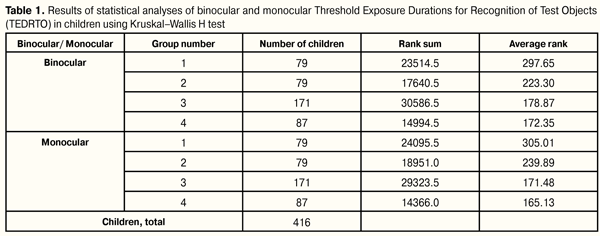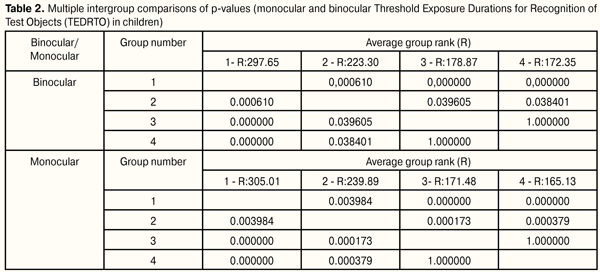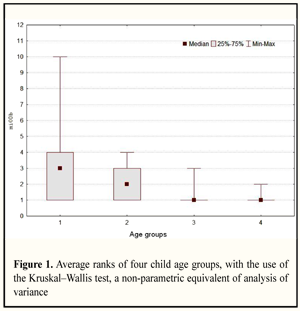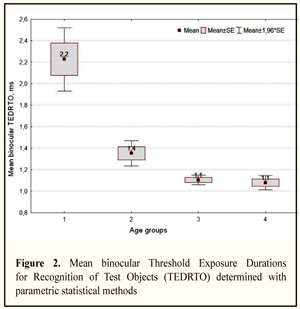J.ophthalmol.(Ukraine).2016;5:41-43.
|
https://doi.org/10.31288/oftalmolzh201654143 Age-related changes in children’s threshold exposure duration for recognition of test objects V.I. Serdiuchenko, Dr Sc (Med) M.B. Zheliznik, Graduate Student Filatov Institute of Eye Diseases and Tissue Therapy, NAMS of Ukraine Odessa, Ukraine E-mail: virais@ukr.net Background: Timely detection of an object in the visual field is of primary importance to adults and children. Purpose: To investigate threshold exposure duration for recognition of test objects (TEDRTO) in normal vision children of various age groups. Materials and Methods: Four hundred and sixteen children (832 eyes; age, 5 to 17 years) with a refraction within the age norm (emmetropia or hyperopia of up to 1.0 D) were included into the study and underwent assessment of TEDRTO with a special electronic apparatus. The apparatus was used to expose a test object (an illuminated Landolt’s ring subtending 8 minutes of arc) against a black background. Results: In children of 5 to 6 years, 7 to 10 years, 11 to 14 years, and 15 to 16 years, binocular threshold exposure durations for recognition of the white test object subtending 8 minutes of arc were found to be 2.1 ± 1.3 ms, 1.4 ± 0.5 ms, 1.1 ± 0.3 ms and 1.1 ± 0.3 ms, respectively. Conclusions: The results obtained can be used as reference values while investigating threshold exposure durations for recognition of test objects in various disorders of the visual system.
Introduction Timely detection of an object in the visual field (possibly, a view of approaching danger), as well as recognition and prompt response to the appearance of this object are of primary importance to any human being or living creature. The findings of such important parameters of visual acuity as expositional visual acuity (EVA) (i.e., visual acuity at various test object exposure durations) and Threshold Exposure Duration for Recognition of Test Objects (TEDRTO) (minimum time required for recognition of the test object subtending a specified visual angle) have been previously reported [1-8]. In addition, the latter index has been assessed in individuals with various refractive statuses, strabismus, and amblyopia [9, 10]. Investigation of age-related changes in TEDRTO in pre-school and school children with normal visual acuity is deemed to be important. The study purpose was to investigate threshold exposure duration for recognition of test objects in children of various age groups with a visual acuity of not less than 1.0, and with a refraction within the age norm. Materials and Methods Four hundred and sixteen children of 5 to 17 years (5 to 7 years, 79 children; 7 to 10 years, 79 children; 11 to 14 years, 171 children; 15 to 17 years, 87 children) were included into the study. Therefore, all child age groups were well represented. Other inclusion criteria were good ophthalmic health, no refracting medium pathology or fundus pathology, and a refractive error within the normal range for the child's age (emmetropia or hyperopia of up to 1.0 D). The study children underwent visual acuity assessment, refractometry, examination of eye position and eye movements, and evaluation of media and fundus. Threshold Exposure Duration for Recognition of Test Objects was assessed with a special electronic apparatus. The apparatus was used to expose a test object (an illuminated Landolt’s ring with a gap randomly at one of the eight positions; ring luminance, 25 candela/mm2) against a black background, with the test object presented for 1 ms to 15 ms, and 1-ms gaps between presentations. If the child failed to identify the target gap direction with the minimum exposure time, the time was increased until he could identify the direction fairly reliably, with not less than 5 correct identifications in succession. The test object had an angular size of 8 minutes of arc. Therefore, its image was projected onto the central fovea; the average angular size of the central fovea has been reported to be 1.3 degrees of arc [11]. The distance from the apparatus to the child under examination was 5 m. Both monocular and binocular TEDRTO examinations were performed in the morning hours under photopic conditions. Due to the features of the data obtained for statistical analyses, we used the Kruskal–Wallis test, which is a non-parametric equivalent of analysis of variance, and extends the Mann-Whitney U test when there are k > 2 independent samples. Results Table 1 presents the results of statistical analyses of monocular and binocular TEDRTO in children of the study using Kruskal–Wallis H test.
Table 2 presents the results of multiple comparisons of p-values between groups (monocular and binocular TEDRTO in children).
The tables presented demonstrate that the children of age group 1 required statistically significantly more time for binocular recognition of white test objects than the children of other age groups. In addition, the mean TEDRTO value in age group 2 was greater than those in the older age groups. No difference in TEDRTO values between group 3 and group 4 was observed (P =1.0). Similar relationships were observed for the TEDRTO related to monocular recognition of test objects. The older the children were, the less time their visual system required for the recognition of the test object presented. The results obtained can be presented graphically (Fig. 1). The figure clearly demonstrates that, as the age group number increases from 1 to 4, the average rank of the group decreases, which corresponds to a decrease in the time required for recognition of the test object. A similar relationship is seen for the use of a parametric statistical method (Table 3). The mean TEDRTO value decreases with age, from 2.2±1.3 ms in children of 5 to 6 years, to 1.1 ± 0.3 ms in children of 11 to 14 years and in children of 15 to 17 years. This relationship between mean TEDRTO value and age group is also shown in Fig. 2.
Therefore, TEDRTO variability diminishes with maturation of the visual system: by the age of 11 years, TEDRTO values become stable, with no further changes. Conclusions In children of 5 to 6 years, 7 to 10 years, 11 to 14 years, and 15 to 16 years, with a visual acuity of not less than 1.0, and with refraction within the age norm, binocular threshold exposure durations for recognition of the white test object subtending 8 minutes of arc were found to be 2.1 ± 1.3 ms, 1.4 ± 0.5 ms, 1.1 ± 0.3 ms and 1.1 ± 0.3 ms, respectively. The results obtained can be used as reference values while investigating threshold exposure durations for recognition of test objects in various disorders of the visual system. References 1.Kolbanov VV. [Investigation of expositional visual acuity in armored vehicle teams]. Mil Med J. 1969;7:72-3 Russian 2.Kolbanov VV, Medvedev VI. [Dynamic characteristics of visual functions]. Hum Physiol. 1979;4(5):687-93 Russian 3.Serdiuchenko VI. [New dynamic techniques for examination of visual functions in refractive and binocular vision anomalies in children]. [Dr Sc (Med) Dissertation]. Odessa: Filatov Institute of Eye Disease and Tissue Therapy; 1995. 257 p. Ukrainian 4.Baron WS, Westheimer G. Visual acuity as a function of exposure duration. J Opt Soc Am. 1973 Feb;63(2)212-9 5.Bokhov B.B., Nosovskii A.M. [The impact of long term isolation on visual acuity]. Aviacosm Ecolog Med. 1997;31(4):41-6 6.Cobb PW. Some experiments on the speed of vision. Trans Illum Eng Soc. 1928; 2(19):150-75 7.Dannenbaum E., Paquet N., Chilingaryan G., Fung J. Clinical evaluation of dynamic visual acuity in subjects with unilateral vestibular hypofunction. Otol. Neurotol. 2009 Apr;30(3):368-72 8.Ferry C, Rand G. Intensity of light and speed of vision studied with the special reference to industrial situation. Part 2. Trans Illum Eng Soc. 1928;23:827. 9.Serdiuchenko VI. [Timing parameters of the resolving ability of the eye and their importance for the diagnosis and treatment of strabismus and amblyopia]. Oftalmol Zh. 1994;5:262--5 Russian 10.Serdiuchenko VI, Zheliznik MB. [Threshold exposure duration for recognition of test objects in children with various refractive statuses]. Oftalmol Zh. 2016;3:3-5 Russian 11.Kravkov S.V. [The eye and its operation]. Moscow, Leningrad: Publishing House of the Academy of Science of the USSR; 1950. p. 15 Russian
|





